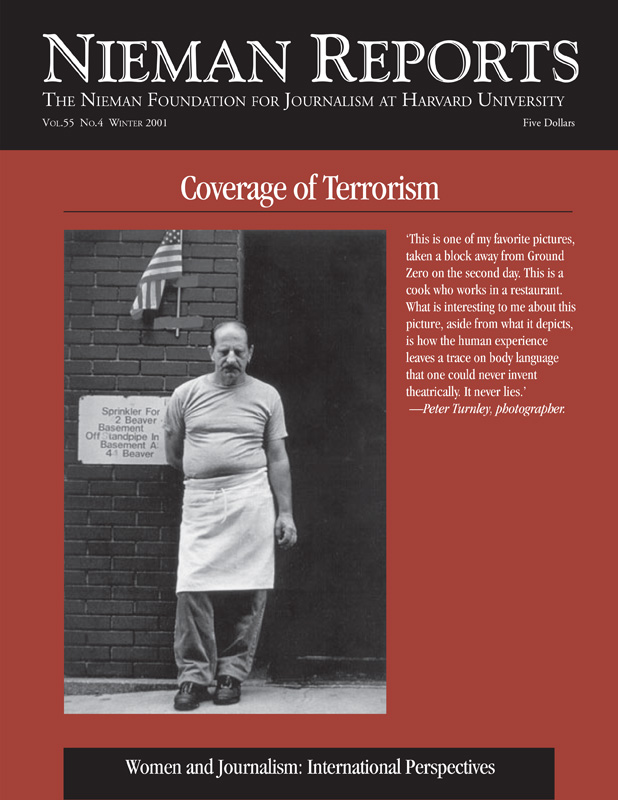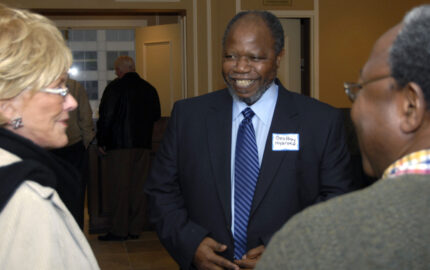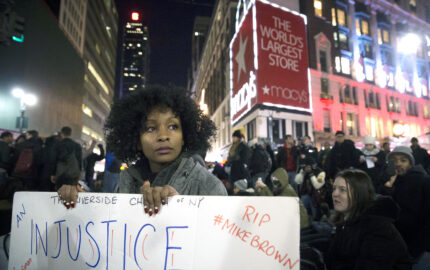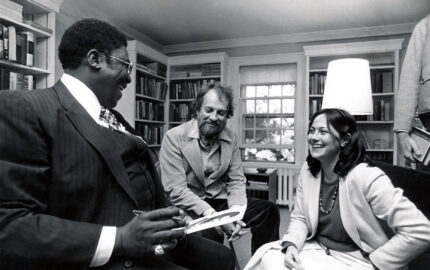Just before nine o’clock on the morning of September 11, I was turning into the parking lot of a venture capital firm in Westport, Connecticut when the cell phone beeped. “Turn on your radio,” my wife said. “A plane has hit the World Trade Center.”
That morning, we did not set out plans for a new media company, or for an old one, or for anything else. Instead, a knot of investors, entrepreneurs, secretaries, the UPS man, and a plumber sat transfixed around a television set pulled onto a long boardroom table and watched with the rest of the world as history exploded in our faces.
So many lives were changed in those few hours. My changes were utterly inconsequential in any greater scheme of things. But that morning did reshape, yet again, my experience as a journalist.
In the late 1990’s, after my Nieman year, I left my editor’s job at The Boston Globe to join the “new media” land rush with a team of wonderful dreamers. We launched an Internet company, struggled up a steep learning curve, raised $70 million, made something cool happen, learned the new media frontier inside and out—then watched as bust followed boom. There was plenty of hubris, a little madness—and the beginnings of a profound change in the flow of information that will play out for years to come.
The company survives, but by September of this year I had long stepped out of the management of HomePortfolio, Inc. I’d written a book chronicling my experience in the decade’s boom and was enjoying a year off—writing, swimming with the kids, and dabbling very lightly in a completely new medium to me: radio.
Boston’s national powerhouse of a public radio station, WBUR, had launched a great interview and call-in show called “The Connection,” hosted by the inimitable Christopher Lydon. When Chris left the station, a stream of well-known broadcasting folk stepped in to take the microphone while station manager Jane Christo looked for a new host. NPR’s Nina Totenberg, Neal Conan, and Robert Siegel took turns. John Donvan from ABC’s “Nightline” sat in. Dick Gordon from the Canadian Broadcasting System was there. Judy Swallow from the BBC. And from the ink-stained world of newspapering, the Globe’s Alex Beam and, once-removed, me. Gordon, a veteran CBC correspondent, was tapped for the job. But for me, just a week at the microphone had been a revelation. This was the original interactive mass medium, interacting with a great national audience and thriving on change, both social and technological.
Four days after the attacks, WBUR executive producer Ian Docherty called on a Saturday afternoon. Demand for coverage of the week’s astounding events were pressing NPR’s resources to the brink, he said. Would I come in Sunday afternoon, ready to help plan and host crisis programming that would go on-air nationally, five hours a night, starting Monday?
On Sunday afternoon, the station’s top brass, producers and technical staff gathered around a white board with the scribbled outline of the programming. A staff of a dozen was put on the rush project. Public radio stations KQED in San Francisco and WNYC in New York mercifully picked up three of the five hours. On Monday, September 17, WBUR’s “Special Coverage” went live for two hours at 7 p.m., flowing over hundreds of local stations in NPR’s network. It’s never stopped.
The show’s format is simple and draws its energy from the diversity of response to stunning events: An eight-minute debrief at the top of the hour, digging in to the latest news from Washington, New York, Islamabad or Kabul, with radio or print reporters on the scene or informed analysts looking on. A longer interview, live, in the 40-minute belly of each hour, going deep with a newsmaker, scholar, artist or commentator, and opening the phones to listener comments and questions. And a “radio diary” in the last five minutes of the show, in which citizens, filmmakers, Afghan exiles and others have poured out their personal thoughts and emotions in taped segments. As host, I’m joined most nights throughout by the show’s excellent news analyst Jack Beatty, a senior editor at The Atlantic Monthly.
So, crisis brings a newspaperman to the radio mike. And here’s what I’ve learned. Radio’s strength is its immediacy in moving information, its tactile power to evoke scenes and elicit response, its ability to share conversations in their full human richness, and its power as a forum, simultaneously public and intimate, for digesting news and debating its meaning. Most newspaper interviews are, of necessity, highly filtered and structured for nuggets. Live radio interviews are full in-the-moment conversations, with all the nuance, emotion and palpability that implies. They can, on a good night, be more nimble and less predictable that many interviews converted to print.
Open the phones on air and the conversation becomes immediately multi-dimensional. Listeners are brave in their questions. This instant interactivity can be intense. Listeners’ challenges and our guests’ responses allow the entire audience to quickly triangulate for a personal view. Listeners can soon gauge a guest’s awareness, sagacity and humanity. The role of the interlocutor—in this case, the host—is more transparent than in print. The audience sees the sausage being made, can poke at facts and their interpretation, and suggest entirely different perspectives on news and analysis—in the midst of an interview! It all happens in “real time,” as I would have said last year, in new-media entrepreneuring mode. In a focused news context, this is thrilling. In a time of crisis, it feels invaluable.
Tom Ashbrook, a 1996 Nieman Fellow, is author of “The Leap: A Memoir of Love and Madness in the Internet Gold Rush.” He was deputy managing editor of The Boston Globe and founding publisher of HomePortfolio Inc.
That morning, we did not set out plans for a new media company, or for an old one, or for anything else. Instead, a knot of investors, entrepreneurs, secretaries, the UPS man, and a plumber sat transfixed around a television set pulled onto a long boardroom table and watched with the rest of the world as history exploded in our faces.
So many lives were changed in those few hours. My changes were utterly inconsequential in any greater scheme of things. But that morning did reshape, yet again, my experience as a journalist.
In the late 1990’s, after my Nieman year, I left my editor’s job at The Boston Globe to join the “new media” land rush with a team of wonderful dreamers. We launched an Internet company, struggled up a steep learning curve, raised $70 million, made something cool happen, learned the new media frontier inside and out—then watched as bust followed boom. There was plenty of hubris, a little madness—and the beginnings of a profound change in the flow of information that will play out for years to come.
The company survives, but by September of this year I had long stepped out of the management of HomePortfolio, Inc. I’d written a book chronicling my experience in the decade’s boom and was enjoying a year off—writing, swimming with the kids, and dabbling very lightly in a completely new medium to me: radio.
Boston’s national powerhouse of a public radio station, WBUR, had launched a great interview and call-in show called “The Connection,” hosted by the inimitable Christopher Lydon. When Chris left the station, a stream of well-known broadcasting folk stepped in to take the microphone while station manager Jane Christo looked for a new host. NPR’s Nina Totenberg, Neal Conan, and Robert Siegel took turns. John Donvan from ABC’s “Nightline” sat in. Dick Gordon from the Canadian Broadcasting System was there. Judy Swallow from the BBC. And from the ink-stained world of newspapering, the Globe’s Alex Beam and, once-removed, me. Gordon, a veteran CBC correspondent, was tapped for the job. But for me, just a week at the microphone had been a revelation. This was the original interactive mass medium, interacting with a great national audience and thriving on change, both social and technological.
Four days after the attacks, WBUR executive producer Ian Docherty called on a Saturday afternoon. Demand for coverage of the week’s astounding events were pressing NPR’s resources to the brink, he said. Would I come in Sunday afternoon, ready to help plan and host crisis programming that would go on-air nationally, five hours a night, starting Monday?
On Sunday afternoon, the station’s top brass, producers and technical staff gathered around a white board with the scribbled outline of the programming. A staff of a dozen was put on the rush project. Public radio stations KQED in San Francisco and WNYC in New York mercifully picked up three of the five hours. On Monday, September 17, WBUR’s “Special Coverage” went live for two hours at 7 p.m., flowing over hundreds of local stations in NPR’s network. It’s never stopped.
The show’s format is simple and draws its energy from the diversity of response to stunning events: An eight-minute debrief at the top of the hour, digging in to the latest news from Washington, New York, Islamabad or Kabul, with radio or print reporters on the scene or informed analysts looking on. A longer interview, live, in the 40-minute belly of each hour, going deep with a newsmaker, scholar, artist or commentator, and opening the phones to listener comments and questions. And a “radio diary” in the last five minutes of the show, in which citizens, filmmakers, Afghan exiles and others have poured out their personal thoughts and emotions in taped segments. As host, I’m joined most nights throughout by the show’s excellent news analyst Jack Beatty, a senior editor at The Atlantic Monthly.
So, crisis brings a newspaperman to the radio mike. And here’s what I’ve learned. Radio’s strength is its immediacy in moving information, its tactile power to evoke scenes and elicit response, its ability to share conversations in their full human richness, and its power as a forum, simultaneously public and intimate, for digesting news and debating its meaning. Most newspaper interviews are, of necessity, highly filtered and structured for nuggets. Live radio interviews are full in-the-moment conversations, with all the nuance, emotion and palpability that implies. They can, on a good night, be more nimble and less predictable that many interviews converted to print.
Open the phones on air and the conversation becomes immediately multi-dimensional. Listeners are brave in their questions. This instant interactivity can be intense. Listeners’ challenges and our guests’ responses allow the entire audience to quickly triangulate for a personal view. Listeners can soon gauge a guest’s awareness, sagacity and humanity. The role of the interlocutor—in this case, the host—is more transparent than in print. The audience sees the sausage being made, can poke at facts and their interpretation, and suggest entirely different perspectives on news and analysis—in the midst of an interview! It all happens in “real time,” as I would have said last year, in new-media entrepreneuring mode. In a focused news context, this is thrilling. In a time of crisis, it feels invaluable.
Tom Ashbrook, a 1996 Nieman Fellow, is author of “The Leap: A Memoir of Love and Madness in the Internet Gold Rush.” He was deputy managing editor of The Boston Globe and founding publisher of HomePortfolio Inc.



